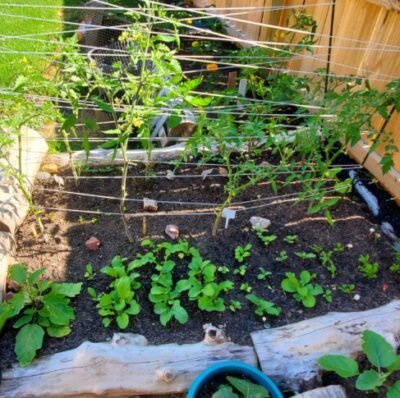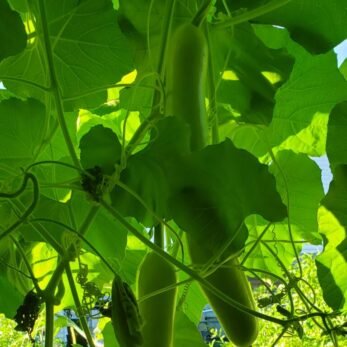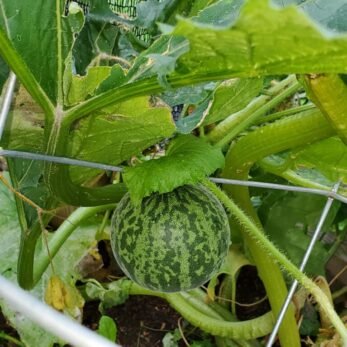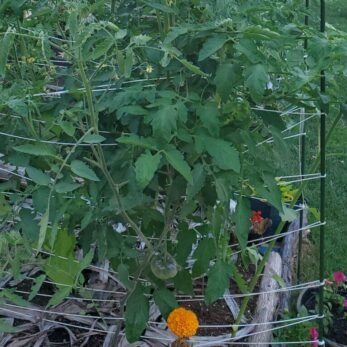How to Support Plants
How to Support Plants
Something that I find is easily overlooked when starting a garden is how to support your plants for best success. It is easy to get in the swing of Spring, get your plants in the ground, and think you’ve got it all figured out. Only to realize later when your plants have grown and can no longer stand up right that you may have had a small oversight.
Choosing the right support system for your plants not only improves plant health but makes it much easier to manage your garden. So let’s take a look at some different options.

How to Support Tomatoes and Tomatillos
Many people would mistakenly tell you that you need tomato cages to support your tomato plants. In their defense, this sounds logical. The problem with tomato cages is they restrict the growth of indeterminate tomatoes, which are plants that will keep growing and growing if given the space to do so. I have had 8 foot tomato plants that are 4 feet wide, that obviously far exceeds the size of a tomato cage.
So instead of limiting my tomatoes, I use a cattle panel hung on T-posts in my garden beds. A cattle panel is typically 16 feet long by about 4 feet tall. As you can imagine, that is a lot of trellis space. The cattle panels are hung roughly 6 inches above the soil level and once the tomatoes reach the panel, I gently tie them to the panel with string. This method makes pruning easy to keep up with and holds the weight of the tomatoes.
The same goes for tomatillos which can be massive plants and rather unruly without the proper support.

How to Support Peppers and Eggplants
Remember those tomato cages we were just talking about? They aren’t completely useless. They are actually great for providing support to your eggplants and pepper plants, as these tend to be more bushy in nature. You could also tie either to a cattle panel, but that may be less practical if you are growing a lot of plants that truly require that level of support.

How to Support Cucumbers and Squash
You will find that there are some types of cucumbers and squash (notably zucchini) that are labeled as bush varieties. This means that ideally they do not require any trellis. Then there are varieties that are vining or pole type, these do require a trellis. For those requiring a trellis, this is where you could utilize another cattle panel. Cattle panels are versatile because they can be bent into an arch with plenty of space to walk under it or they can be cut and placed in a tepee type configuration. These panels are also one of the strongest methods in my opinion for supporting a fruit that can be rather heavy in nature.
Of note on the bush varieties, some of these can grow a bit tall and therefore be unstable. This is another place I like to utilize the tomato cages just so they do not fall over.

How to Support Melons and Pumpkins
Melons and pumpkins can be tricky for the backyard gardener if you are working with a small space. Typically, you could let these grow in a mound in the ground without too much fuss. However, if you need to utilize vertical space to optimize what you can grow……..you guessed it, a cattle panel can help solve this issue. Small to medium size melons and pumpkins can be tied to the panel and mesh hammocks can be wrapped around the fruit itself and tied to the panel for additional support.

What is so great about cattle panels for plant support?
As you can tell, I am partial to the cattle panel. There are 3 main reasons for this, the first being versatility. You can use cattle panels to trellis basically anything and in multiple configurations. The second reason is ease of use. I’ve tried other methods and they just made my life more difficult than necessary. The third reason is the cost. A 16 ft x 4 ft cattle panel is going to run about 35.00, and T-posts to hold it in place about 8.00 each (you need at least 2 T-posts but 3 is better if hanging them horizontally, 2 will hold an arch in place). That is a lot of trellis space for such little cost when you compare it to the other options in big box stores.

Alternative Plant Support Options
So let’s talk about what else you could use. My first season of gardening, I used a combination of a foldable tomato cages (about $10.00), one that can be made into a triangle or used straightened out, as well as a wrought iron trellis that was only 2 feet wide x 6 feet tall and cost me 20.00. Did this work? Yes, for the very tiny garden that I had space for it did. However, it limited me on how tall my tomatoes could grow and only gave me enough space for 2 tomato plants and a cucumber. The wrought iron trellis held only 2 pea plants.
My second season with a larger garden, I used green garden stakes from Walmart and thin rope. While this got the job done, the weight of the tomatoes became too much for this method and the entire support system started to bow inwards halfway through the season. It also only allowed about 4 feet of tomato height. Not only that, but the rope was not able to be reused for the next season. You might think that this was a cheap solution, but I spent roughly $25.00 to $30.00 in stakes and about $10.00 in rope.
As you can see, if I had just spent the 60.00 on the cattle panel and T-posts to start, I would have saved money and had a more than adequate support system in place for years to come. Plus, I would have had the space to add additional plants. My third season, I did just that. I have a large garden, so I saved enough to get 4 panels, and 12 T-posts. Going into my 4th season this year, I will be adding 3 more panels.
What if you have a small garden budget?
What if you truly don’t have the budget for your first panel or stakes and string? Heat treated pallets are a potentially free or low-budget way to support your plants. You can use entire pallets, screw multiple together, or deconstruct them and reconfigure them into something usable for you. This is also an option that will provide for multiple years. Just be extra cautious to make sure you are not picking up any chemically treated pallets. You can usually find these on Facebook Marketplace, Craigslist, or OfferUp.

Overall Thoughts on How to Support Your Plants
First and foremost, always remember that no 2 gardens look alike. Just because I prefer cattle panels, doesn’t mean you must have them as well to be successful. This is just what works best for me. I want to share that success so it might be of benefit to your garden. It is ok to have combinations of trellising systems. It is ok to do it cheap or free, or do it differently.
Just be sure to consider the overall price of what you are picking and the sustainability of those options. I am always about saving where I can. Sometimes that means spending more money up front to save long term.
Keep it in the back of your mind as well that the easier you make gardening, the more present you will be in the garden, which will lead to the most success. Whatever you decide, pick what works best for your garden.
Happy Planting!

Author
liv@livlifeoutdoors.com
Related Posts
5 Easy Plants to Grow for Beginners
5 Easy Plants to Grow for Beginners Starting out can feel overwhelming, but there are some pretty easy plants to grow for...
Saving on Garden Supplies – What is in store for next season?
Saving on Garden Supplies – What is in store for next season? As you put your garden to bed and reflect on...
Simple Guide For End of Season Garden Cleanup
Simple Guide For End of Season Garden Cleanup The end of season garden cleanup is a bittersweet time. A brisk chill...
Next Garden Season: A Plan for Growth
Next Garden Season: A Plan for Growth It may seem early, but now is the time that I plan ahead for the...
How to Harvest the Best Tomatoes You will Ever Eat
How to Harvest the Best Tomatoes You will Ever Eat Harvesting the best tomatoes from the garden is what we strive for...
How to Get Rid of Garden Waste
How to Get Rid of Garden Waste Is garden waste eating away at your sanity? You pruned your heart away, weeded until...